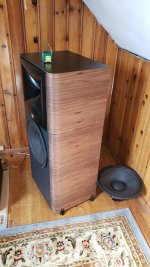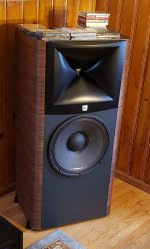Iwata 300 /Yamaha JA6681B off-axis response.
Radian AH425/745Be
https://www.diyaudio.com/community/threads/jmlc-and-yuichi-horns-measurements.395046/post-7250809
Radian AH425/745Be
https://www.diyaudio.com/community/threads/jmlc-and-yuichi-horns-measurements.395046/post-7250809
Last edited:
Note here that compared to his prior use of the 425s, Pierre said of the TH4001 horn, “By virtue of its low profile, the sectoral horn allows positioning the two drivers closer together.”
A waveguide with different angles on H&V might appear to help with ceiling reflections and even reduce baffle spacing.. but does it achieve these goals or make them harder to reach?
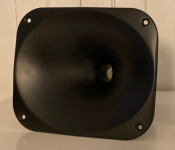
If you want to make one dimension more narrow and still have it work down to the same frequency, it needs to be both taller and deeper.

Often this is not what you see. When the vertical is cut down, or is designed to meet the horizontal at the mouth, it cannot maintain control of the lower frequencies as the horizontal can. The crossover frequency may need to be raised to avoid...

If you want to make one dimension more narrow and still have it work down to the same frequency, it needs to be both taller and deeper.
Often this is not what you see. When the vertical is cut down, or is designed to meet the horizontal at the mouth, it cannot maintain control of the lower frequencies as the horizontal can. The crossover frequency may need to be raised to avoid...
A few years back I heard the JBL 4367 back-to-back with a bunch of great Revel speakers. I liked the 4367 a lot.

The JBL waveguide is very asymmetric; much more so than the JBL M2. Both speakers use very similar components, IIRC the tweeter is identical. (JBL D2430K)

The JBL waveguide is very asymmetric; much more so than the JBL M2. Both speakers use very similar components, IIRC the tweeter is identical. (JBL D2430K)
- Patrick Bateman
- Replies: 60
- Forum: Multi-Way
Horns and waveguides increase their output by directing it into a narrow beam. For instance, a compression driver on a horn may produce as much as 110dB with a single watt, by focusing all it's energy in a narrow beam.
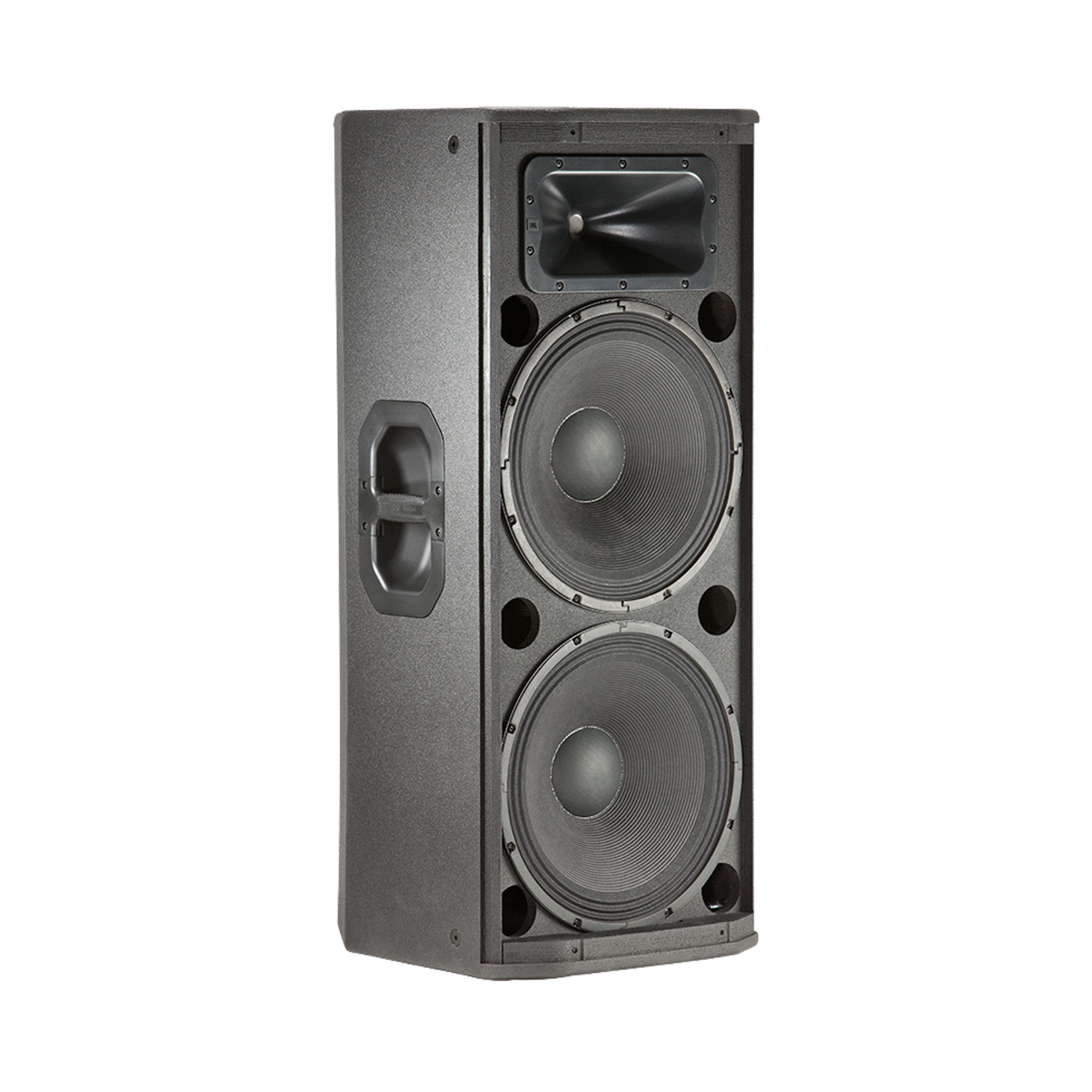
One of the downfalls with this is 'pattern flip.' Pattern flip is when the waveguide or horn loses 'pattern control' on one axis but not the other
For instance, the waveguide on this JBL PRX 425 will control horizontal directivity down to about 1350Hz, but...

One of the downfalls with this is 'pattern flip.' Pattern flip is when the waveguide or horn loses 'pattern control' on one axis but not the other
For instance, the waveguide on this JBL PRX 425 will control horizontal directivity down to about 1350Hz, but...
- Patrick Bateman
- Replies: 70
- Forum: Multi-Way
Acoustic Horn Design – The Easy Way (Ath tool)
This is an associated thread for a waveguide generator called Ath (Advanced Transition Horn), version 4.
Ath is a piece of software for designing waveguides and horns. At the same time it makes it possible to easily simulate their acoustic behaviour by means of FEA (BEM) via ABEC/AKABAK tool.
The current Ath release is available at https://at-horns.eu
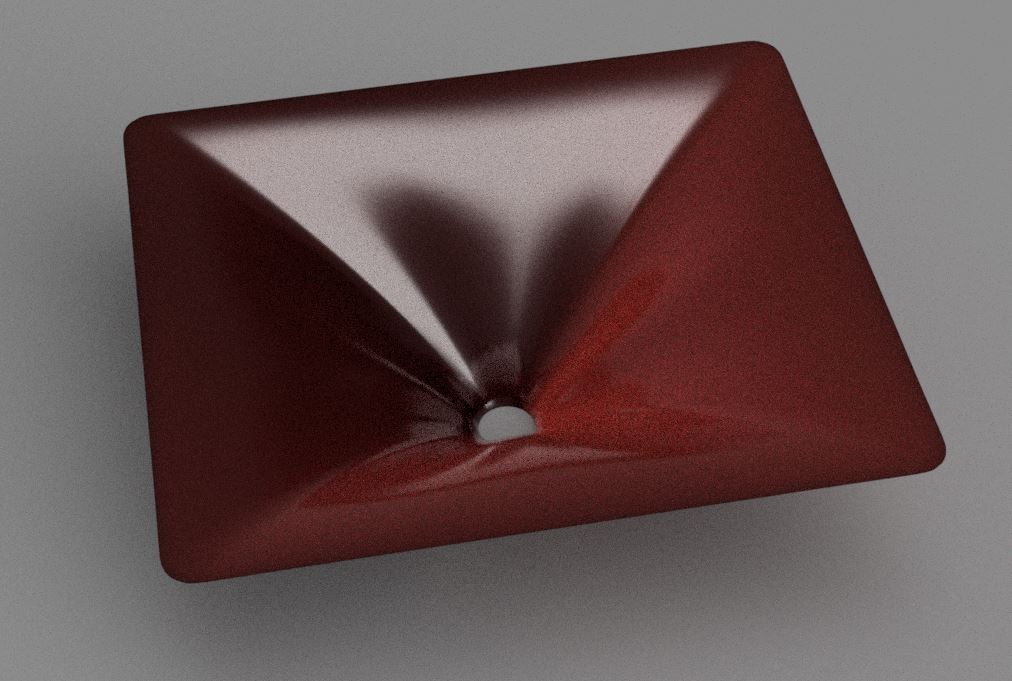
Thread milestones (last edited 26.12.2020...
This is an associated thread for a waveguide generator called Ath (Advanced Transition Horn), version 4.
Ath is a piece of software for designing waveguides and horns. At the same time it makes it possible to easily simulate their acoustic behaviour by means of FEA (BEM) via ABEC/AKABAK tool.
The current Ath release is available at https://at-horns.eu
Thread milestones (last edited 26.12.2020...
Are you planning to listen to your horn system at 50cm (19.5 inches) from the mouth 😉 ?Iwata 300 /Yamaha JA6681B off-axis response.
The frequency response is very smooth for that horn/driver combination.Radian AH425/745Be
Interesting Pierre chose to boost it's 13kHz on axis response from -4dB (raw) to +4dB.
Do you have a preference for the TH-4001 clone or the AH425 horn's dispersion pattern?
Art
Regarding this page https://www.azurahorn.com/JA6681B on 425 Horn (2).pdf , Martin did say those were his drivers and enjoyed using them though eventually gave them to his son when he switched to using other drivers.I think there is one big question that you have skipped straight past.
Which driver is the AH425 designed for?
The AH webpage shows it with a JA6681B, and if it is made to fit that driver.
The JA 6681B look very well behaved and easy to xo on that horn.
You will have hf irregularities with the 745 due to the difference in throat design.
It cannot physically fit both drivers.
But to be clear it was never my intention to want to physically swap out the horn for use between both drivers/crossovers. Instead, the goals is finding the single best driver for this horn and which can also be ideally cross overed to my midwoofers, at least for two way system.
https://josephcrowe.com/blogs/news/altec-416-8b-in-100l-sealed
IIRC, that horn wasn't specifically designed for the 6681B driver. https://www.diyaudio.com/community/threads/compression-driver-impedance-question.318749/post-5351706
Currently, only it's just that Reddit poster with the 425/Radian 951Be, though his are actively crossed. AFAIK, if was only Gary and Pierre who ever did a 745Be/425 combo, but both eventually switched to using different horns and/or drivers. Gary said he couldn't perfect the filtering which made the Radian Be sound strident, harsh or otherwise unacceptable. Pierre more likely nailed the filter but ultimately preferred to continue using the 745Bes in a different horn-and which seems the wisest choice for me, since I must completely rely on Troy Crowe to make this one and done build happen perfectly the first time.
Gary posted here last year and apparently still enjoys the match. My worry with using the Yamahas is if the diaphragms lose their tonality and/or neutrality, due to damaging micro stresses , which Weltersys and/or others cite are inevitable-and which might occur sooner than later due to the age of the drivers-there are currently no replacements. Weltersys had mentioned an EV driver?
Yes - these are constant directivity.Referring to the sketch of my below or my room, is my room too small to use with CD horns because those horns-unlike the JMLC AH425-would create too many reflections which could mask details and deform the timbre of sound, even if it could deliver some kind of appreciated "spaciousness"?,
By constant directivity horn system, you mean like Robh36306 prefers, or horns like these?
https://audiohorn.net/x-shape-horn/
https://audiohorn.net/next-gen-bi-radial-horn/
https://www.bcspeakers.com/en/products/horn/1-4/0/ME464
https://www.limmerhorns.de/292/
You can also get narrow CD horns for lower reflections. The benefit is the reflections will sound more similar to the original sound! A narrowing directivity will give a little "dull" reflections/room sound when it's linear on axis. This can actually fit your room or listening habits - but a constant directivity speaker will react more neutral to different rooms.
A circular design MUST NOT be bad! It just shows inperfections stronger as an elliptical design. So a great circular horn - will be great ;-)
There is no "single best driver" for any horn, though individuals may have a preference for the attributes of some drivers over others.Instead, the goals is finding the single best driver for this horn and which can also be ideally cross overed to my midwoofers, at least for two way system.
So far, you have not even considered any of the horns Yamaha designed for that driver.IIRC, that horn wasn't specifically designed for the 6681B driver.
Gary certainly did not say he was trying to perfect a filter to make the the Radian Be "sound strident, harsh or otherwise unacceptable".Gary said he couldn't perfect the filtering which made the Radian Be sound strident, harsh or otherwise unacceptable.
He did alternate between different drivers, crossovers, with and without tweeters while using the AH425 horns as his preferences evolved.
Pierre chose to boost it's 13kHz on axis response from -4dB (raw) to +4dB.Pierre more likely nailed the filter but ultimately preferred to continue using the 745Bes..
Some would consider that rising high frequency response to sound "sound strident, harsh or otherwise unacceptable".
Others would describe it as "detailed" or "revealing".
I've used the EV DH1A and DH1Amt (same driver, different throat size) extensively on a wide variety of horns, they are/were excellent drivers with similar response to many current 3" diaphragm drivers, though much heavier than most.Weltersys had mentioned an EV driver?
Assuming your Radian Neo 745Be drivers have the same response as the ones we have seen measurements of, they have smoother, more extended high frequency response with a shorter decay time than the DH1A.
Art
Last edited:
As shown in the last sketch submitted, my room is too small for and/or preferred seating location prohibits corner speaker placement. Thus, diagonal placement-between the east wall and the open hallway-is likely the only option.Are you now planning to build your horns into a room corner? What acoustic support do you think a room provides?
Don’t know how to answer the second question.OK, so you are more "impressed" by an 80x60 than a 60x40. What is your preferred polar pattern?
But between those CD horns, what I found more impressive about that B&C horn was that it had more output over a longer horizontal angle than the Ciare horn. But given how these horns are classified by their Hor vs. Vert dispersion dimensions, I still don't think I know enough to make a useful choice for a CD horn. Searching [ how is an 80 x 60 horn different from an 60 x 40 horn ] I found this.
https://www.diyaudio.com/community/threads/help-me-understand-coverage-dispersion-of-horns.419591/
Hopefully, these explanations will be useful enough to the undereducated to decide on the CD horn best for my room size and the rest of its acoustical features. As my sketching skills are as poor as my diy skills, for the requested description of the west side of my acoustic space, I will provide photos from the end of the 11 ft south wall to across the 3.5 ft open space into the kitchen and staircase to its right. Will those photos and my last sketch together provide enough information to facilitate CD horn selection?
Meanwhile, my builder’s end of April deadline seriously looms, and the AH425 is the horn which you, AllenB and Camplo have argued offer apparently too many advantages for me to ignore. If so, then with Arez and others I first need help to finish deciding on a driver for it, before shipping the horns to Troy Crowe.
Last edited:
If you don't have a preferred polar pattern, you could answer you don't.Don’t know how to answer the second question.
An angle has no length or vertical or horizontal dimension, it is a direction.But between those CD horns, what I found more impressive about that B&C horn was that it had more output over a longer horizontal angle than the Ciare horn. But given how these horns are classified by their Hor vs. Vert dispersion dimensions, I still don't think I know enough to make a useful choice for a CD horn.
Assuming you have a rectangular house, each corner describes 90 degrees in a horizontal direction, regardless of the wall length.
If you cut up a pizza into 4 equal pieces, each will have a 90 degree corner angle (360/4=90) if you cut it into 6 equal pieces (360/6=60), each will have a 60 degree corner angle.
The diameter (the length across) of the pizza makes no difference to the angle.
Twenty degrees different in each direction, for as far as the sound waves travel before reflecting off some boundary.Searching [ how is an 80 x 60 horn different from an 60 x 40 horn ] I found this.
Photos or a sketch won't indicate your preference for the ratio of direct to reflected sound for each frequency range, or whether a "constant directivity" horn would fit your preferences better than one with a uniform reduction in directivity at higher frequencies.As my sketching skills are as poor as my diy skills, for the requested description of the west side of my acoustic space, I will provide photos from the end of the 11 ft south wall to across the 3.5 ft open space into the kitchen and staircase to its right. Will those photos and my last sketch together provide enough information to facilitate CD horn selection?
As Troy Crowe says in the Toids interview linked on his website, his exponential horns are inspired by Jean-Michel Le Cléac'h horn designs (like the AH425..) so he obviously finds advantages to them over "constant directivity" horns.Meanwhile, my builder’s end of April deadline seriously looms, and the AH425 is the horn which you, AllenB and Camplo have argued offer apparently too many advantages for me to ignore. If so, then with Arez and others I first need help to finish deciding on a driver for it, before shipping the horns to Troy Crowe.
The Radian745Be/AH425 combo has a very smooth and extended frequency response, and is appreciated for that by many who have decided to choose it.
You may prefer your combo too, if you were to decide to use it.
We'll never know until you try 😉
Art
Yes, but also specified for use with my midwoofers-and which are clones of g3dhal's. I would say that would narrow choices at least a bit-and for which I'm seriously running out time to decide on.There is no "single best driver" for any horn, though individuals may have a preference for the attributes of some drivers over others.
I never knew they existed so could have no way of knowing how they might work with my midwoofers, much less how they might sound.So far, you have not even considered any of the horns Yamaha designed for that driver.
Pierre chose to boost it's 13kHz on axis response from -4dB (raw) to +4dB.
Some would consider that rising high frequency response to sound "sound strident, harsh or otherwise unacceptable". Others would describe it as "detailed" or "revealing".
"Pierre more likely nailed the filter but ultimately preferred to continue using the 745Bes.. IN THE TH-4001 HORNS.
When you keep taking my statements out of context it just keeps spiraling my journey around endlessly.
Is that your goal?
I'd hate to think so, especially being aware of the end of month deadline I'm facing.
Whatever frequency response tweaks Pierre made were either kept or rejected. But my point is that he ultimately settled with using the 745Bes in the 4001 horns.
Obviously, but I think that even I am qualified to conclude that it's a matter of degree, as the AH425 likely focuses a lot more of the AF range more narrowly than this horn. https://cdn.shopify.com/s/files/1/0...BMS_4591-8_off-axis3_480x480.png?v=1649504045As Troy Crowe says in the Toids interview linked on his website, his exponential horns are inspired by Jean-Michel Le Cléac'h horn designs (like the AH425..) so he obviously finds advantages to them over "constant directivity" horns.
The Radian745Be/AH425 combo has a very smooth and extended frequency response, and is appreciated for that by many who have decided to choose it.
Really? Whether here or at least five other such forums, you'll be hard pressed to find others using that particular driver in any build, much less with that horn. And that's a fact; I've scoured at least that number of forums: What's Best, HiFi Haven, Audio Asylum, AVS, Klipsch, Audiokarma, Audiocircle, Audiotalk and more. Can't recall finding any such combo. Thus, given Gary and Pierre's long but eventually discontinued experiences with same, it seems prudent to avoid the 745Be/AH425 combo.
Which is precisely why I had asked about the practicality of asking Troy to build two horn combos: the AH425/ (Yamaha?) driver + (Raal?) tweeter combo and the 745Be/ 1.4" CD (make/model?) combo, and their respective passive crossovers to work with my midwoofers.Photos or a sketch won't indicate your preference for the ratio of direct to reflected sound for each frequency range, or whether a "constant directivity" horn would fit your preferences better than one with a uniform reduction in directivity at higher frequencies.
You have the 745Be's, the AH425s and the same midwoofer/box that Gary used. He had a sketch of the crossover he used for that combo (or msg him for his last iteration) and cobble that together and listen. Won't cost much and you will at least have a point of reference as to where you want to go next. If you don't hear said hardness, all the better.
Edit: or are the midwoofer/boxes with Troy?
Edit: or are the midwoofer/boxes with Troy?
The passive M2 120 X100 is right up there with the Array and has even better image stability. ....
Man those M2 "clones" look fantastic! I have the official M2s, but those cabinets make me jealous. Do you have more pictures of the cabinets?
That would be the reasonable way to proceed but I do believe Troy has the midwoofer/boxes.You have the 745Be's, the AH425s and the same midwoofer/box that Gary used. He had a sketch of the crossover he used for that combo (or msg him for his last iteration) and cobble that together and listen. Won't cost much and you will at least have a point of reference as to where you want to go next. If you don't hear said hardness, all the better.
Edit: or are the midwoofer/boxes with Troy?
Man those M2 "clones" look fantastic! I have the official M2s, but those cabinets make me jealous. Do you have more pictures of the cabinets?
Thank You! Lucky you I wouldn't mind the real deal and I think the stock ones look good. Here is a couple and one before vernier. Those 1/4 rounds really make for a stiff cabinet and are very easy to use. The pictures hide the imperfections.
Rob 🙂
Attachments
Those round-overs really sets it off! The actuals have a chamfer, which also looks good, but the round-over seems just a bit beyond.
From that illustration, as those rays look to have identical angles how could they not be symmetrical?Your room walls will react to high frequency sound waves similar to a shining a light at a mirror, the angle of the reflected waves are equal to the incident ray. Non-symmetrical reflections will distort the sense of space present in the recording and make localization cues amorphous.
As you said "Visual observations can be informative too." So, I don't get when you say that photos of the kitchen that adjoins the hallway and living room wouldn't give enough structural-and thereby acoustical info. You hardly have to be an acoustician or a carpenter to know how those kitchen cabinets and countertops are constructed, and what that vinyl tiled floor is about.Can't imagine an enclosed space with an "absent west wall", so can't usefully speculate at all about acoustic results.
So, then for an AH425/JA6681B combo-and with the horn's edge placed as suggested to avoid "frequency climbing"The choice of a laterally offset tweeter position insures that response can only match a target in one position in the room.
https://www.diyaudio.com/community/attachments/screen-shot-2025-04-06-at-12-35-10-am-png.1445106/ - can/should a ribbon or AMT tweeter be placed above the horn, without problems?
The midwoofers are with Troy.Edit: or are the midwoofer/boxes with Troy?
https://josephcrowe.com/blogs/news/altec-416-8b-in-100l-sealed
Unfortunately, as most here have rightly concluded I am no kind of diyer, a status I'm endeavoring to change at least by expanding my understanding of loudspeaker design and acoustics. I had Jim Salk clone these from Gary's sketches and construction photos because I had planned to have Jim finish building the system as per Gary's crossover. I even sent Jim the same Slagle autoformers for attenuating that Gary used. But not long afterwards when I read how disappointed Gary became with the Radians-at least in those horns and/or with that EQ (or vs. his ears?) that I chose to err on the side of caution. This happened just in time as Jim was set to retire, so I had him ship the midwoofers and autoformers to Troy and the rest of the parts back to me.
All I know for sure is that Gary's been very happy with the AH425/Yamaha JA6681B combo, albeit without tweeters for the last seven years.
But I wonder if he notices the frequency "climbing" that Pierre did, who had also used (and perhaps had more successfully EQed) the AH425/Radian Be combo for some time. Weltersys's solution for that is scratch Gary's wooden U-mount and Pierre's metal tripods
https://www.azurahorn.com/azurahorn_horns_files/Pierre Lavoie 425.jpg and instead place the horns much closer to the midwoofers.
https://www.azurahorn.com/azurahorn_horns_files/jpeg-optimizer_IMG_0570.jpeg
But by doing so, might not a ribbon or AMT tweeter be successfully utilized if placed above the horns?
Last edited:
Can you give examples of commercially available narrow constant directivity horns? Would one be like this one? https://usspeaker.com/ciare pr614-1.htmYes -these are constant directivity.
You can also get narrow CD horns for lower reflections. The benefit is the reflections will sound more similar to the original sound! A narrowing directivity will give a little "dull" reflections/room sound when it's linear on axis. This can actually fit your room or listening habits - but a constant directivity speaker will react more neutral to different rooms.
- Home
- Loudspeakers
- Multi-Way
- 1.4" or 2" throat large constant directivity horns you can actually buy!

